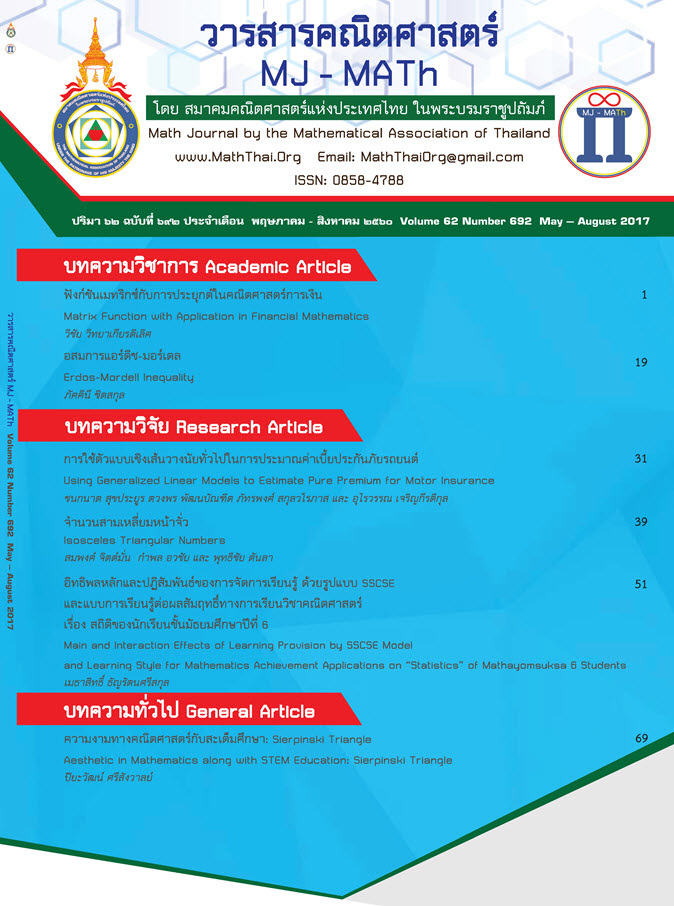Main and Interaction Effects of Learning Provision by SSCSE Model and Learning Style for Mathematics Achievement Applications on “Statistics” of Mathayomsuksa 6 Students
Main Article Content
Abstract
The objective of this research were to 1) study main and interaction effects
of learning provision by SSCSE model and learning style for mathematics
achievement application on statistics of mathayomsuksa 6 student 2 ) compare of
mathematics achievement application on statistics of mathayomsuksa 6 student
after learned by SSCSE model and conventional method and 3 ) compare of
mathematics achievement application on statistics after learned by SSCSE with
7 0 % criteria. The research samples were 7 1 students in mathayomsuksa 6 in
second semesters academic year 2 0 1 4 at school of Rachineeburana, Nakhon
Pathom province. The research design was experimental design with pretestposttest,
experimental and control group design. The research instruments were
learning plan, achievement test and David Kolb learning style test. The data
analyses applied were percentage, arithmetic mean, standard deviation, t-test and
two way analysis of variance.
The result of this research indicates: 1 ) the main effect discovered in the relationship between SSCSE model and mathematics achievement application on statistics of mathayomsuksa 6 student. However, not the main effect discovered in the relationship learning style and no interaction effect between SSCSE model and learning style for mathematics achievement application on statistics of mathayomsuksa 6 students was significantly at .0 5 levels 2 ) mathematics achievement application on statistics after learned by SSCSE model was higher than conventional method at .05 statistical significantly levels and 3) mathematics achievement application on statistics after learned by SSCSE was higher than 70% criteria at .05 statistical significantly levels.
Article Details
References
Academic Department, Strategies for Teaching which Consistence by Learning Style, Bangkok: Kurusapa Lat Phrao Press, 2001 (in Thai).
[2] กัลยา วานิชย์บัญชา, หลักสถิติ, กทม: สำนักพิมพ์แห่งจุฬาลงกรณ์มหาวิทยาลัย,2551. K. Wanitchabancha, Principle of Statistics, Bangkok: Chulalongkorn University Press, 2008 (in Thai).
[3] คณะกรรมการการศึกษาขั้นพื้นฐาน, หลักสูตรแกนกลางการศึกษาขั้นพื้นฐาน พุทธศักราช 2551, กทม: โรงพิมพ์ชุมนุมสหกรณ์การเกษตร, 2551.
Office of the Basic Education Commission, Core Curriculum for Basic Education Act 2551, Bangkok: Chumnumgankaset Press, 2008 (in Thai).
[4] ชานนท์ จันทรา, ขั้นตอนการวิธีพิสูจน์ทางคณิตศาสตร์สำหรับครู, กทม:สานักพิมพ์มหาวิทยาลัยเกษตรศาสตร์, 2553.
C. Jantra, Algorithm of Math-Proof for Teacher, Bangkok: Kasetsart University Press, 2010 (in Thai).
[5] ชูศรี วงศ์รัตนะ, เทคนิคการใช้สถิติเพือ่ การวิจัย, นนทบุรี: ไทเนรมิตกิจ อินเตอร์โปรเกรสซิฟ จำกัด, 2552.
C. Wongrattana, Technique for Using Statistics for Research, Nonthaburi: Trinearamitgit Interprogressive, 2009 (in Thai).
[6] ญานิศา ศรีโชติ, “การพัฒนาชุดกิจกรรมด้วยวิธีการสอนแบบ SSCS เรื่อง สมการเชิงเส้นตัวแปรเดียวสา หรับนักเรียนชัน้ มัธยมศึกษาปีที่ 1,” การศึกษาค้นคว้าด้วยตนเอง, กศ.ม, มหาวิทยาลัยนเรศวร, 2554.
Y. Srichoat, “The Development of Learning Kit by SSCS Model Application on Linear Equation with One Variable for Mathayomsuksa 1 Students,” Independent Study of Master Degree on Education, Nareasuan University, 2011 (in Thai).
[7] ทิศนา แขมมณี, ศาสตร์การสอน: องค์ความรู้เพื่อการจัดกระบวนการเรียนรู้ทีมี่ประสิทธิภาพ, กทม: สานักพิมพ์แห่งจุฬาลงกรณ์มหาวิทยาลัย, 2552.
T. Kammanee, Science of Teaching: Knowledge for the Effective in Learning Management, Bangkok: Chulalongkorn University Press, 2009 (in Thai).
[8] พิชิต ฤทธิ์จรูญ, หลักการวัดและประเมินผลการศึกษา, กทม: เฮ้า ออฟ เคอร์มิสท์, 2552.
P. Ritjaroon, Principle of Education Measurement and Evaluation, Bangkok: House of Kermit, 2009 (in Thai).
[9] มณีรัตน์ พันธุตา, “การศึกษาความสามารถในการแก้ปัญหาคณิตศาสตร์และผลสัมฤทธิ์ทางการเรียนของนักเรียนชั้นมัธยมศึกษาปีที่ 4 โดยใช้รูปแบบ SSCS ร่วมกับกระบวนการแก้ปัญหาของ POLYA,” วารสารศึกษาศาสตร์, ปีที่ 8, ฉบับที่ 4, 2557.
M. Panthuta, “A Study of Mathematics Problem Solving Ability and Achievement of Mathayomsuksa 4 Students by SSCS Model and Polya,” Journal of Education, vol. 8, no. 4, 2014 (in Thai).
[10] เยาวดี รางชัยกุล วิบูลย์ศรี, การสร้างแบบทดสอบผลสัมฤทธทิ์ างการเรียน, กทม: สานักพิมพ์แห่งจุฬาลงกรณ์มหาวิทยาลัย, 2555.
Y. R. Wibunsri, Construction of Achievement test, Bangkok: Chulalongkorn University Press, 2012 (in Thai).
[11] ล้วน สายยศ และอังคณา สายยศ, เทคนิคการวัดผลการเรียนรู้, กทม: สำนักพิมพ์ชมรมเด็ก, 2543.
L. and A. Saiyot, Technique of Learning Assessment, Bangkok: Chomromdek Press, 2000 (in Thai).
[12] สุภาพร ปิ่นทอง, “การเปรียบเทียบความสามารถในการแก้ปัญหาคณิตศาสตร์ เรื่อง อสมการ และเจตคติต่อการเรียนวิชาคณิตศาสตร์ ของนักเรียนชั้น
มัธยมศึกษาปีที่ 3 ที่ได้รับการสอนโดยใช้รูปแบบการจัดการเรียนรู้ SSCS และการสอนโดยใช้เทคนิค KWDL,” วิทยานิพนธ์ปริญญาการศึกษามหาบัณฑิต สาขาวิชาการมัธยมศึกษา, มหาวิทยาลัยศรีนครินทรวิโรฒ, 2554.
S. Phindthong, “A Comparison of Mathematics Problem Solving Skills Application of Inequality and Attitudes towards Mathematics of
Mathayomsuksa 3 Students, who Learning by SSCS Model and KWDL Technique,” Thesis of Master Degree on Secondary Education,
Srinakarinwirot University, 2011 (in Thai).
[13] อาภรณ์ ใจเที่ยง, หลักการสอน, กทม: สา นักพิมพ์โอเดี่ยนสโตร์, 2553.
A. Jaitheang, Principle of Teaching, Bangkok: Ordain Store Press, 2010 (in Thai).
[14] K. David, The Organizational Behavior Reader, Englewood Cliffs, New Jersey: Prentice-hall Inc., 1995.


